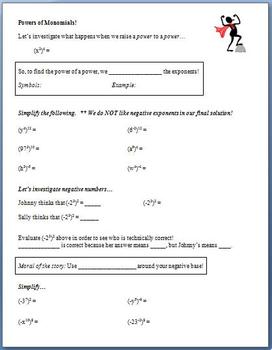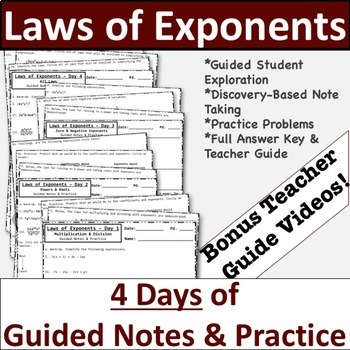Laws Of Exponents Guide Notes

What Are Exponents? Let's begin this lesson by writing the following on a piece of paper: 3 x 3 x 3 x 3 x 3 x 3 x 3 x 3 x 3 x 3 x 3 x 3 x 3 x 3 x 3 After the fourth or fifth 3, you were probably starting to get bored or annoyed trying to write out the entire expression. Just know, you are definitely not alone in these feelings.
Yamaha tzr 50 2007 service manual. If you are looking for a book Yamaha tzr 50 2007 service manual in pdf format, in that case you come on to loyal site. We furnish full edition of this ebook in doc,. TZR50'03 / X-POWER'03. SERVICE MANUAL. This manual to carry out maintenance and repair work on Yamaha /MBK motorcycles basi. TZR50 / X-POWER. Total height. Height of the seat. View and Download YAMAHA TZR50 owner's manual online. TZR50 Motorcycle. Motorcycle YAMAHA TT-R50E Owner's Service Manual. 2008 Yamaha TZR50 — Owner's Manual. Posted on 16 Sep, 2015. Model: 2008 Yamaha TZR50 Pages: 78. File size: 2 MB. Download Manual. Yamaha Models.
Laws of Exponents Study Guide Rules: To multiply powers with the same base, keep the base and add the exponents To divide powers with the same base, keep the base and subtract the exponents. ~Mr Mac’s Math Notes~~Mr Mac’s Math Notes~ Laws of Exponents There is a set of rules for evaluating expressions involving integral exponents. Guided Notes for lesson P.2. Using the rules of exponents, multiply the powers of ten. (add the exponents) 3. Be sure your final answer is in scientific notation.
Laws Of Exponents Guided Notes

Instead of taking the time to write out long strings of numbers like the one above, mathematicians decided to create the exponent. An exponent is just a shorthand way of saying to multiply the same thing by itself for a specified number of times. Looking at the example, we see that the number 3 is being multiplied by itself 15 times. Using exponents, we can write this one of two ways. The first is using a superscript. You begin by writing the number being multiplied (3) and then the number of times it is being multiplied (15) as a superscript, as shown here. 3 15 The second method of writing exponents, and the one you will encounter most throughout this lesson, is the use of a caret, or hat.
In computer language, this is much easier to create than the superscript. Like with the superscript, you begin by writing the number being multiplied, followed by the caret, and then the number of times it's being multiplied.
Using out example, we would write the exponent as 3^15. Like with many things in math, there is a set of rules, or properties, that govern how we use exponents. In the case of this lesson, we will be discussing seven of these properties as well as exploring examples of how these rules work. Don't worry though, I will include a chart with all of the properties at the end to help you organize everything! Throughout this lesson you will experience the following important vocabulary:.
Base is defined as the number being multiplied by itself. Exponent is defined as the number of times you are multiplying the base. In the example, our base would be the number 3 because it is being multiplied repeatedly, and our exponent would be the number 15 because it describes the number of times 3 is being multiplied by itself. Zero & Negative Exponents First, let's look at the zero property of exponents. This is probably one of the easiest properties to remember when it comes to exponents. In simple terms, it means that whenever a number is being multiplied by itself 0 times, the answer will always be 1.
This is written as: a^0 = 1 However, it is important to note that a cannot equal 0 for this property to work. 'Some examples include:. 4^0 = 1. 7^0 = 1. 2^0 = 1. 675^0 = 1 Negative Exponents Our next property, the negative property of exponents, is also fairly straightforward. It states that whenever you experience a negative exponent, the number you are multiplying becomes a fraction.
For example, you might be given the following exponent, 3^(-2). This means that we must rewrite our exponent as a fraction: 1 / 3^2 Once we re-write the exponent, we can then find our solution.
In this case, we are multiplying the number 3 by itself two times, so our solution is: 3^(-2) = 1 / (3^2) = 1 / (3. 3) = 1/9 The property itself is written as: a^(- b) = 1 / a^ b Again, it is important to note that a cannot equal zero for this property to work. Product Properties There are two rules that deal with the product (or multiplication) of two numbers. One is used when the exponents have the same base, while the other is used when the exponents themselves are the same.

Product of Powers The product of powers property is used when both numbers have the same base but different exponents. Let's use 2^2. 2^4 as an example. In both numbers, we have the same base of 2. The product of powers rule tells us that we can keep this same base and add our exponents together. Thus: 2^2. 2^4 = 2^(2 + 4) Now that we have re-written the expression, we can work it out to get a solution: 2^2.
2^4 = 2^(2 + 4) = 2^(6) = 64 The property itself is written as: a^ b. a^ c = a ^ ( b + c) Like with the previous two properties, a cannot equal 0 for this property to work. Power of a Product The power of a product property is used when we have different bases but the same exponent. Let's use 3^2 x 5^2 as an example. In both numbers, we have the same exponent of 2. The power of product rule tells us that we can keep this same exponent and multiply our two bases together.
Thus: 3^2. 5^2 = (3. 5)^2 Now that we have re-written the expression, we can work it out to get a solution of: 3^2. 5^2 = (3. 5)^2 = (15)^2 = 225 The property itself is written as: b^ a x c^ a = ( b x c)^ a In this case, b and c cannot equal 0 for this property to work. Quotient Properties Similar to products, we must also have a set of rules for when we are working with quotients, or the division of two exponential numbers.
Again, one property is used when the numbers have the same base, and the other property is used when the exponents themselves are the same. Quotient of Powers The quotient of powers property is used when both numbers have the same base but different exponents. This rule follows very closely with the product of powers property. Let's use 3^5 / 3^2 as an example. Like with the product of powers property, we keep our base of 3, but instead, we subtract our exponents rather than add them.
Thus: 3^5 / 3^2 = 3^(5 - 2) Now that we have re-written the expression, we can work it out to get a solution of: 3^5 / 3^2 = 3^(5 - 2) = 3^(3) = 27 The property itself is written as: a^ b / a^ c = a^( b - c) Please note that a cannot equal 0 for this property to work. Power of a Quotient & Power of a Power The power of a quotient property is used when both numbers have different bases but the same exponent. This rule follows very closely with the power of a product property. Let's use 8^2 / 4^2 as an example. Like with the power of a product property, we keep our same exponent of 2, but since we're working with division, we are going to divide our bases rather than multiply them. Thus: 8^2 / 4^2 = (8 / 4)^2 Now that we have re-written the expression, we can work it out to get a solution of: 8^2 / 4^2 = (8 / 4)^2 = (2)^2 = 4 The property itself is written as: b^ a / c^ a = ( b / c)^ a Please note that b and c cannot equal 0 for this property to work.
Power of a Power I know it has been a long haul, but we have finally reached our final property! In the power of a power property you will find an exponential number being raised to another exponent. For example, you might see (4^6)^3. This means that we are multiplying the number 4 by itself 6 times, and then doing this for a total of 3 times. I know that sounds a little crazy but there is a super easy way of simplifying this expression so that it can be solved in no time. The power of a power rule tells us that when we encounter a situation like the one above, we can simply multiply the two exponents together and then work the solution from there.
Thus, (4^6)^3 = 4^(6 x 3) Now that we have re-written the expression, we can work it out to get a solution of: (4^6)^3 = 4^(6 x 3) = 4^(18) = 68,719,476,736 There are no side notes related to 0 for this property. Lesson Summary You made it! In this lesson, you not only learned what an exponent means, but also the seven properties that you must follow when working with exponents. As promised, you will find a chart with these seven rules for a quick reference. Give yourself a pat on the back, because you just covered a lot of material and are now an expert at working with exponents! Property Expression Zero Exponents a^0 = 1 Negative Exponents a^(- b) = 1 / a^ b Product of Powers a^ b. a^ c = a ^ ( b + c) Power of a Product b^ a x c^ a = ( b x c)^ a Quotient of Powers a^ b / a^ c = a^( b - c) Power of a Quotient b^ a / c^ a = ( b / c)^ a Power of a Power ( a^ b)^ c = a^( b.
c).